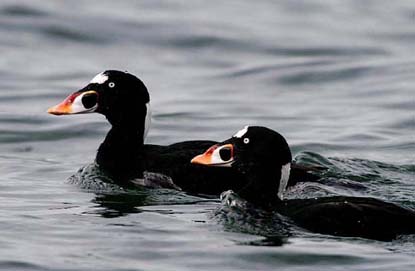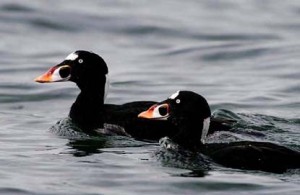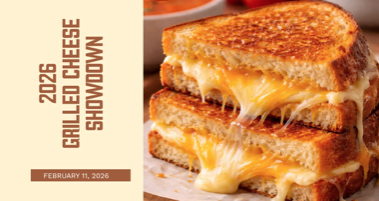— from Russel Barsh —
How appropriate that dozens of Surf Scoters visited Eastsound to dine on herring eggs the week before the Orcas Island Bird & Wildlife Festival!
Surf Scoters are hard to miss. Drakes have a conspicuously massive orange and white bill with a large black polka dot on each side. Their scientific name, Melanitta perspicillata, comes from the Latin perspicilli, “spectacles”. The bill serves as a shell-cracker for crabs and bivalves, an elegant example of the evolution of highly specialized beaks in birds—in this case, one that serves both for processing food and attracting a mate!
Like many other “sea ducks”, Surf Scoters divide their life cycle between fresh water and marine waters. Thousands of Surf Scoters winter here in the Salish Sea, diving in shallow bays for shellfish (particularly mussels). In March and April, they congregate on the Gulf and San Juan Islands’ herring spawning grounds to feast on this rich “caviar”.
As spring weather spreads northwards up the Pacific Coast, the herring spawn farther and farther north as well. Surf Scoters follow, taking advantage of these dense, concentrated patches of food to fuel their migration to the Arctic lakes and wetlands where they breed in summer, feeding now on dense swarms of freshwater insects and insect larvae.
When the higher latitudes begin to cool again in August and September, Surf Scoters and their chicks slowly work their way southward, re-appearing in our waters by November—dreaming of springtime and herring caviar, no doubt!
Many other seabirds rely on herring eggs for an extra spring energy boost, for migration as well as egg production. Gulls, Cormorants, and Goldeneyes and Buffleheads are all commonly observed working freshly deposited herring spawn in East Sound.
**If you are reading theOrcasonian for free, thank your fellow islanders. If you would like to support theOrcasonian CLICK HERE to set your modestly-priced, voluntary subscription. Otherwise, no worries; we’re happy to share with you.**









